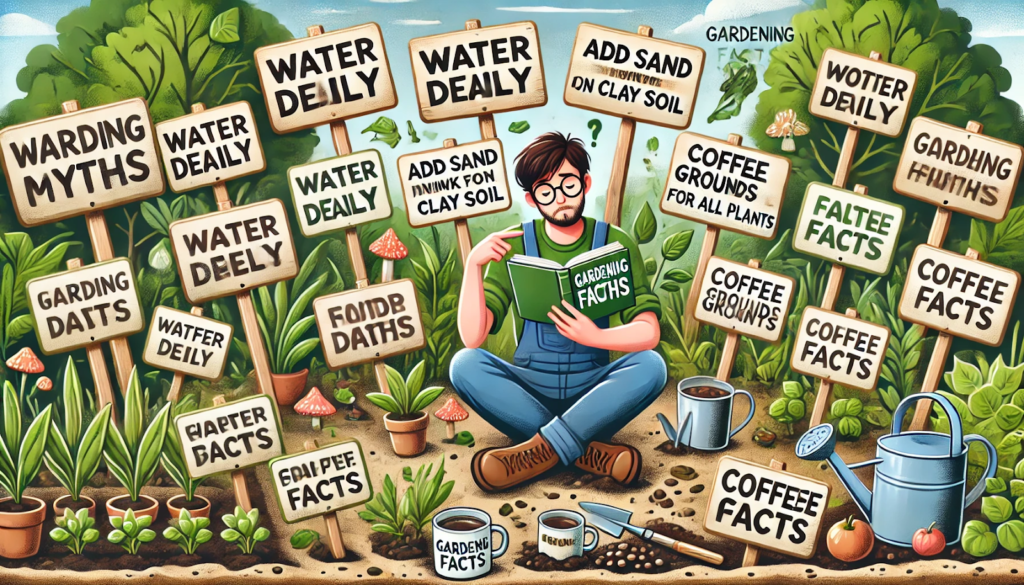Gardening advice gets passed down through generations, but not all of it is accurate. Some tips sound convincing but actually do more harm than good. Believing gardening myths can lead to poor plant health, wasted effort, and disappointing results.
Let’s debunk 10 of the most common gardening myths—and what you should be doing instead.
1. “Water Your Plants Every Day”
❌ The Myth: Daily watering keeps plants healthy.
✅ The Truth: Most plants prefer deep, infrequent watering that encourages strong root growth. Overwatering can lead to root rot and fungal issues.
Do this instead: Water only when the top inch of soil is dry, and adjust based on the weather and plant type.
2. “Add Sand to Clay Soil to Improve Drainage”
❌ The Myth: Sand breaks up heavy clay soil.
✅ The Truth: Mixing sand with clay can create a cement-like texture. Instead, add organic matter like compost to improve aeration and structure.
Do this instead: Mulch and amend with aged compost or leaf mold.
3. “Coffee Grounds Are Good for All Plants”
❌ The Myth: Coffee grounds are a universal fertilizer.
✅ The Truth: Coffee grounds are acidic and may not benefit all plants. They can also compact in soil and block air and water flow.
Do this instead: Compost your coffee grounds or use only in moderation for acid-loving plants like blueberries.
4. “More Fertilizer = Better Growth”
❌ The Myth: Feeding plants more will boost their health.
✅ The Truth: Over-fertilization can burn roots and encourage weak growth. Plants need balanced nutrition.
Do this instead: Follow recommended application rates and use organic fertilizers that release slowly.
5. “You Can’t Garden Without Full Sun”
❌ The Myth: Shade means no garden.
✅ The Truth: Many plants, especially leafy greens and herbs, thrive in partial or dappled shade.
Do this instead: Choose shade-tolerant crops like lettuce, kale, mint, and ferns.
6. “Cutting Grass Short Makes It Grow Slower”
❌ The Myth: A short lawn reduces mowing.
✅ The Truth: Cutting grass too short stresses the turf and makes it vulnerable to weeds and drought.
Do this instead: Mow at a height of 2.5–3.5 inches to promote deep roots and healthy growth.
7. “You Have to Till Your Garden Every Season”
❌ The Myth: Tilling is essential for soil health.
✅ The Truth: Tilling can disturb beneficial soil life, lead to compaction, and increase erosion.
Do this instead: Try no-dig gardening, add compost as a top layer, and mulch to maintain healthy soil.
8. “All Bugs Are Bad”
❌ The Myth: Insects destroy gardens.
✅ The Truth: Many insects like ladybugs, bees, and lacewings are essential for pollination and natural pest control.
Do this instead: Learn to identify beneficial bugs and encourage biodiversity with flowering plants.
9. “Epsom Salt Is a Miracle Cure for Plants”
❌ The Myth: Epsom salt boosts all plant growth.
✅ The Truth: While magnesium sulfate can help certain deficiencies, it’s not a universal fix and can harm soil balance if overused.
Do this instead: Test your soil before applying and use targeted amendments only when needed.
10. “You Must Paint Pruned Tree Branches”
❌ The Myth: Paint seals pruning wounds and prevents disease.
✅ The Truth: Tree paint can trap moisture and slow healing. Most trees recover best on their own.
Do this instead: Make clean, angled cuts and let trees heal naturally.
Conclusion: Garden Smarter, Not Harder
Gardening success depends on facts—not folklore. By questioning popular advice and focusing on science-based practices, you can grow healthier plants, save time, and avoid costly mistakes.
Let go of the myths and trust your own experience, observation, and the ever-growing world of horticultural knowledge.






